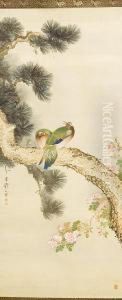So Shiseki Paintings
So Shiseki, also known as So Shiseki or Su Shihsek, was a Japanese painter and print artist from the Edo period, renowned for his contributions to the development of the nanga or bunjinga style of painting in Japan. Born in 1712 in Edo (now Tokyo), Shiseki was a self-taught artist who drew inspiration from Chinese literati painting traditions, which emphasized personal expression and the scholar-artist ideal.
Shiseki was an intellectual and a painter who sought to transcend the purely decorative aspects of the popular ukiyo-e style that flourished during his time. Instead, he pursued a more scholarly and introspective approach to art, which was in line with the ideals of Chinese literati who were more interested in personal cultivation and expression than in commercial success. His works often featured landscapes, flowers, and birds, executed with an emphasis on simplicity and an airy, suggestive use of brushwork that left much to the imagination.
Although Shiseki never studied in China or with a Chinese teacher, he was deeply influenced by the Chinese literati painting style, which he adapted to his Japanese context. His commitment to nanga was not only artistic but also ideological, as it was associated with the values of Confucianism and Daoism, promoting a life in harmony with nature and the pursuit of scholarly endeavors.
Shiseki's influence on the nanga movement was significant, and he became a central figure among literati artists in Japan. His style was characterized by a blend of poetic sensibility and painterly technique, which was emulated by many artists of his time and later generations. Shiseki's work bridged the gap between the Chinese literati ideals and the Japanese artistic landscape, helping to create a unique cultural synthesis that would continue to evolve long after his death in 1786.
